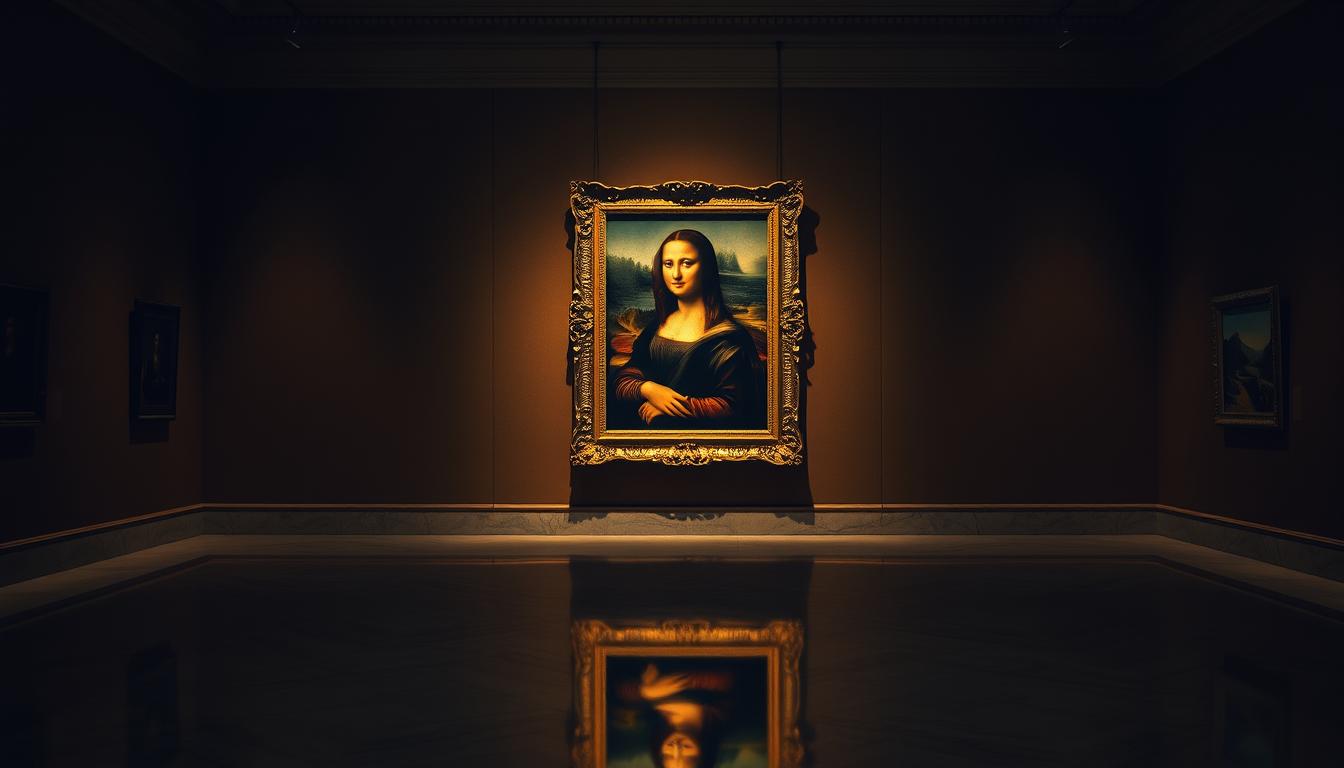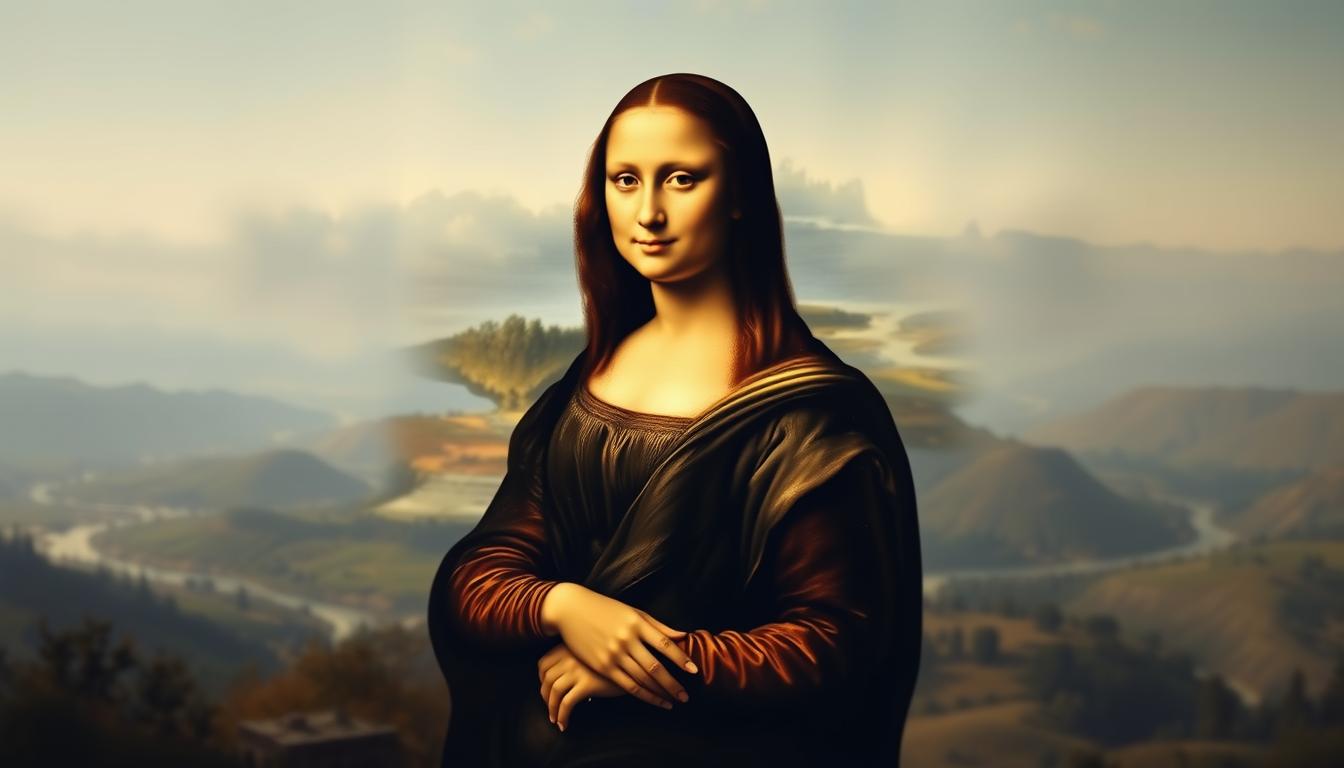Quick answer: the painting belongs to the French Republic and is on public display at the Louvre in Paris.
Painted by Leonardo Vinci on a poplar panel between about 1503 and 1517, this half-length work shows a woman often linked to Lisa del Giocondo. King Francis I acquired it after the artist's death in 1519, and it joined the Louvre collection in 1797.

Millions of people visit each year to study the sitter's subtle smile and the artist's technique. Its fame rose sharply after the 1911 theft and its recovery in 1914, turning a national treasure into a global masterpiece.
Below, we explain legal ownership, where to see it today, and why this painting remains central to art history and museum life in Paris.
Key Takeaways
- The French Republic legally owns the work and it hangs at the Louvre in Paris.
- Leonardo painted it in oil on a poplar panel in the early 1500s.
- The sitter is traditionally identified as Lisa del Giocondo; her smile shaped modern portrait art.
- King Francis I brought the piece to France after 1519, and it entered the Louvre in 1797.
- The 1911 theft boosted global interest and helped make it the world’s most famous painting.
- Visitors planning a trip can learn where to stand and what to look for before they go.
- For more background, see a detailed history on this reference.
Quick answer: Who legally owns the Mona Lisa and where you can see it today
The short legal answer: France holds ownership and the painting is on public display at the Louvre Museum in Paris.
Current owner: The French Republic acquired the work after Leonardo’s death in 1519. It is public property, held in trust by the state and administered for all citizens.
Current location: Since 1797 the painting has been exhibited at the Louvre. Today it sits in the Salle des États, inside the Denon Wing, protected behind bulletproof glass and with controlled lighting for conservation.
- The Louvre safeguards and displays the work; it is not privately owned or on loan.
- The gallery uses a freestanding wall to set viewing distance and manage heavy crowds.
- Plan your visit to the Denon Wing and follow signs to the Salle des États for the best route.
Who owns the Mona Lisa portrait?
What began as a private studio piece soon entered royal hands and then national care.
From King Francis I to the French state: how ownership passed and persisted
After Leonardo's death in 1519, King Francis I acquired the work and added it to the royal collection. That collection later became property of the nation during the French Revolution. By 1797 the painting joined the Louvre as state-held property.
The chain of custody runs clearly: artist’s studio → Francis I → royal collection → French Republic. This legal trail explains why the painting is not a private heirloom or for sale.
Why it’s considered a national treasure and public property
As part of national patrimony, the work is protected from permanent export and commercial sale. The state is responsible for conservation, access, and long-term care.
"State stewardship keeps the masterpiece in public hands for generations."
- The painting's status prevents permanent loan or sale.
- Public ownership secures conservation decisions over market pressures.
- Its role in history and culture makes it a national symbol, displayed for millions.
Where is the portrait of Mona Lisa?
Short answer: You’ll find the mona lisa in the Denon Wing of the Louvre Museum, displayed in the Salle des États.
The Salle des États uses a freestanding wall so every visitor sees the picture at a set distance. A bulletproof glass case protects the painting while glazing and climate control manage humidity and dust.
The Louvre’s Salle des États: room layout, viewing distance, and protective glass
The layout favors clear sightlines and security. Staff guide visitor flow with ropes and pathways to reduce crowding.
Lighting is calibrated so you can still read surface tones and modeling from a respectful distance.
How the display evolved to handle millions of visitors
Major rehangs and renovations in the 1990s, early 2000s, and 2019 refined traffic patterns. The museum balances conservation, visibility, and visitor experience.
"The case and glazing provide both environmental control and strong physical security."
- Denon Wing location with clear signage for easy navigation.
- Freestanding wall and bulletproof glass set a consistent viewing distance.
- Expect crowds; plan visits early or late for shorter lines.
| Feature | What it does | Effect for visitors | Notes |
|---|---|---|---|
| Location | Salle des États, Denon Wing | Easy to find on museum map | Staff can direct you |
| Protection | Bulletproof glass case and climate control | Strong security, preserved surface | Flash photography restricted |
| Layout | Freestanding wall and traffic flow | Consistent viewing distance, managed crowds | Optimized after major renovations |
How Leonardo’s masterpiece reached France
Leonardo vinci moved to France in 1516 and brought several prized works with him. He spent his final years at Clos Lucé under King Francis I’s patronage.
Leonardo da Vinci’s final years and the acquisition by Francis I
Scholars believe the mona lisa began in Florence around 1503–1506 and may have seen adjustments through 1517. Leonardo likely kept the panel until he traveled to France, carrying it as part of his studio's collection.
After his life ended in 1519, Francis I acquired the painting and added it to the royal holdings. This royal acquisition anchored its stay in France for centuries.
From royal collection to public museum after revolutionary change
For decades the work moved among royal residences, from Fontainebleau to Versailles. Revolutionary reforms later converted crown property into national patrimony.
The painting entered the Louvre in 1797, starting its public museum life in Paris. These provenance steps — artist’s move, royal purchase, and state transfer — explain why the French state curates and conserves the work today.
"State stewardship preserved the work for public viewing over private sale."
- Panel medium and refined technique reflect Leonardo’s long practice.
- Sitter identification with lisa gherardini ties the commission to a Florentine merchant family.
The theft that made it world famous
A daring August night in 1911 turned a quiet gallery into a global sensation.
Vincenzo Peruggia’s 1911 heist and the two‑year disappearance
On August 21, 1911, Louvre employee Vincenzo Peruggia hid overnight and removed the mona lisa from its wall. He reportedly had helped fit a simple protective glass case earlier and used that familiarity to slip the work out.
Peruggia walked out with the painting concealed and kept it hidden for about two years. Newspapers worldwide chased the story and photos of the empty wall fed public fascination.
Recovery, triumphant return, and the surge in global fame
When the man tried to sell the piece in Florence, authorities recovered it in 1913. It toured briefly in Italy before the official return to Paris on January 4, 1914.
"The return turned a famous painting into a world famous phenomenon."
- The 1911 case revealed security gaps at a major museum.
- Press coverage and courtroom drama pushed the painting into everyday talk.
- The episode led to stronger protections, changed display practice, and higher public interest in the work.
For a detailed contemporary account of the theft that made it a masterpiece, see this report.
Protection, conservation, and the glass case
A series of mid‑century incidents reshaped how museums protect one of art’s best‑known works. Conservators and security staff learned that display must pair safety with careful climate control.

From a thrown rock to bulletproof glazing: in 1956 a rock struck the panel and dislodged pigment near the left elbow. Earlier, a man had tried to cut and remove the piece, which prompted installation of protective glazing.
From 1956 vandalism to modern bulletproof glass
The 1956 event was a turning point. After that, conservators upgraded the display to include sealed cases and later bulletproof glass.
Recent protest incidents and why the painting remained safe
Over decades, attackers tried different tactics: red paint sprayed on a copy in Tokyo (1974), a thrown teacup at the Louvre (2009), and food protests in 2022 and 2024. None reached or harmed the painted surface.
"The sealed, climate‑controlled case and vigilant staff keep the work safe while letting visitors see it."
- Layered defense: barriers, glazing, guards, and surveillance.
- Environmental controls: humidity and temperature monitored to protect the poplar panel.
- Design as prevention: the case reduces accidental touches and crowd pressure.
| Risk | Response | Effect | Notes |
|---|---|---|---|
| Vandalism (1956 rock) | Stronger glazing, conservation checks | Stopped direct impact on paint | Led to sealed display practice |
| Attempted theft | Improved security protocols | Reduced access opportunities | More guards and restricted approaches |
| Protests (food, liquids) | Bulletproof glazing and quick response | Surface remained intact | Made headlines but no damage |
| Long‑term decay | Climate control and monitoring | Stable paint and panel condition | Ongoing conservation program |
In short, modern protection combines science and security. This approach keeps the painting safe as part of public patrimony and ensures future visitors can view it in good condition.
The subject, the sitter, and the artistry behind the icon
A quiet domestic commission grew into a lasting icon through subtle craft and human presence.
Most scholars identify the subject as Lisa Gherardini, the wife of Florentine merchant Francesco del Giocondo. Her married name, La Gioconda, gave the work its Italian title and links the image to real family life in early 16th‑century Florence.
Technically, this small painting is oil on a poplar panel. Leonardo vinci used extremely thin glazes and delicate hatching to build form.
Sfumato around the eyes and mouth creates the famous elusive smile that seems to change with the viewer's angle. Atmospheric perspective ties the sitter to a distant landscape, fusing human presence and nature.
"The subtle layering and soft edges give a living presence that still fascinates artists and visitors."
| Feature | Detail | Effect on viewers |
|---|---|---|
| Sitter | Lisa Gherardini (La Gioconda) | Personal, relatable subject |
| Medium | Oil on poplar panel | Fine glazes, long working time |
| Technique | Sfumato and atmospheric perspective | Soft transitions, shifting smile |
| Size | ~77 cm × 53 cm | Intimate scale, close study |
Knowing the sitter and craft enriches your visit. Even from a distance, these choices explain why this work endures in art history and why so many artists study its modeling and gaze.
Exhibitions, evacuations, and journeys beyond Paris
From hidden châteaux to packed metropolitan galleries, this work’s journeys are part of its story.

During World War II, curators moved the painting repeatedly to keep it safe. It travelled from the Louvre to Château d’Amboise, Loc-Dieu Abbey, and Château de Chambord.
Later it reached the Musée Ingres in Montauban. Careful packing and strict security helped protect fragile paint and the poplar panel. The work returned to Paris in 1945 and public access was restored.
Blockbuster tours that shaped public access
In 1963 the painting toured the United States, appearing at the Metropolitan Museum of Art and the National Gallery of Art. Museums reported as many as 40,000 visitors a day.
In 1974 it travelled to Tokyo and Moscow, expanding its reach as a world famous, cultural ambassador. Such tours required tight climate control and expert handlers.
- WWII evacuations: multiple safe sites across France to protect national patrimony.
- 1963 US tour: unprecedented attendance, headline museum events.
- 1974 Asia‑Europe trip: diplomatic and public impact on global audiences.
| Period | Route | Impact |
|---|---|---|
| 1940s | Châteaux and provincial museums | Protected during conflict; return in 1945 |
| 1963 | New York → Washington | Massive daily visitors; boosted fame |
| 1974 | Tokyo → Moscow | International diplomacy; new audiences |
"Each journey balanced public demand with conservation priorities."
Today, major tours are rare due to conservation needs and ownership responsibilities. These movements across a century helped make a famous painting into a world symbol while reminding museums how to protect priceless works.
Planning your visit to see the Mona Lisa
Plan your Louvre visit around timing and movement to make a front-row view realistic.
Best times: Aim for weekday mornings at opening or evenings late in the day. Those two parts of each day usually have fewer crowds and shorter lines.
What to expect at the Salle des États
The painting sits behind bulletproof glass with a set barrier to keep a managed distance. Expect a brief, focused viewing window rather than extended close study.
Smart tips:
- Head straight to the Salle des États after entry to improve chances of a front spot.
- Buy timed-entry tickets and study the museum map to plan an efficient route.
- Build in buffer time for lines and keep your visit to about a few minutes at the case so others can enjoy it.
- Dress comfortably, hydrate, and follow staff directions for smooth flow.
"Quick photos are fine, but step aside promptly so others can enjoy their moment."
| Tip | Why it helps | When to use |
|---|---|---|
| Timed ticket | Reduces queue time | Any day with high demand |
| Go early or late | Fewer crowds, better photos | Weekdays outside holidays |
| Head straight to Salle des États | Better chance for front viewing | Upon museum entry |
Conclusion
In summary, legal stewardship and public access explain how this painting stays visible to millions.
The French Republic holds legal title, and you can see the mona lisa at the Louvre in Paris, displayed in the Salle des États under protective glass.
Its long life in public care keeps the painting safe while letting visitors study the sitter and subject across centuries.
Conservation, security, and careful display make this work a lasting part of world art and museum life.
For visitors and artists alike, a brief encounter in the Salle des États can reveal new details in this tiny but iconic portrait.
Enhance Your Space with Unique Modern Masterpieces
Are you inspired by the innovative mediums and conceptual depth highlighted in our exploration of contemporary art? You’re not alone! Today’s art enthusiasts are seeking cultural relevance and emotional connections in their artwork. However, finding pieces that resonate with modern themes and fit your unique style can be a challenge. That’s where we come in!
At Rossetti Art, we specialize in canvas prints, original paintings, and modern sculptures that celebrate the spirit of now. Each piece created by Chiara Rossetti brings a personal touch that connects deeply with current social narratives—just like the modern masterpieces discussed in the article. Don’t miss out on the chance to elevate your home decor with breathtaking artwork that speaks to your values and aesthetic. Explore our collection today and find your perfect piece! Act now, and transform your space into a gallery of inspiration!
FAQ
Who currently holds legal title to the famous painting?
The French Republic holds legal title. The work is part of France’s national collection and is administered by the Louvre Museum in Paris.
Where can visitors see this iconic work today?
It is on permanent display in the Louvre’s Salle des États. The painting sits behind protective glass so visitors view it from a set distance.
How did ownership move from Renaissance Italy to France?
Leonardo brought the piece to France late in his life. King Francis I acquired several of the artist’s works, and those pieces entered royal holdings that later became state property after the Revolution.
Why is the painting treated as a national treasure and public property?
Its cultural importance, artistic innovation, and historical value led authorities to protect it as part of the national heritage. Laws and museum policies keep it accessible to the public while ensuring long‑term preservation.
What happened during the famous 1911 theft?
A Louvre employee, Vincenzo Peruggia, removed the panel and hid it for about two years. When recovered in 1913, the theft had already boosted the work’s international fame.
How has display and security changed to handle millions of visitors?
The painting moved behind reinforced, climate‑controlled glass and into a dedicated, monitored gallery. Crowd flow measures and barriers control viewing distance to protect the panel.
How did wartime evacuations protect the work during World War II?
Museum staff packed and moved artworks across France to secure châteaux and safe sites. Those relocations helped preserve the collection until the postwar return to Paris.
What conservation steps keep the painting stable today?
Conservators monitor humidity, temperature, and light exposure. Cleaning and analysis use noninvasive methods, and the bulletproof glass case provides physical protection from vandalism and accidents.
Who is believed to be the sitter, and what names connect to her identity?
Scholars widely identify Lisa Gherardini, wife of Francesco del Giocondo, as the sitter. Italian sources often call the work La Gioconda in reference to that family name.
What materials and techniques did the artist use?
The piece is oil on a poplar panel. Leonardo’s sfumato technique softens transitions and contributes to the subtle expressions that fascinate viewers.
Has the painting toured outside France?
Yes. It traveled for major exhibitions, including high‑profile loans to the United States and Japan. Each tour requires strict security and conservation protocols.
Are there special tips for visiting the Salle des États?
Arrive early or late in the day to avoid peak crowds, book timed tickets, and be prepared for a brief, closely monitored viewing. Photography rules and barrier limits mean most visitors see the work from a short distance.






Leave a comment
This site is protected by hCaptcha and the hCaptcha Privacy Policy and Terms of Service apply.